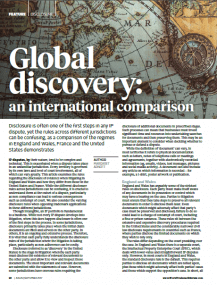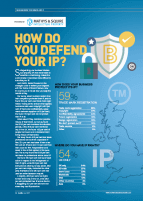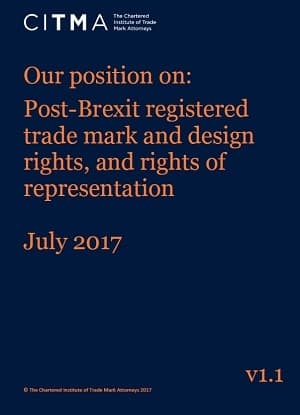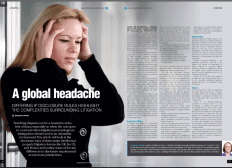From 7 November 2017, Thailand will become the 99th member of the Madrid System after Thailand’s government deposited its instrument of accession to the Madrid Protocol with WIPO’s Director General.
By simply filing a single international application and paying one set of fees, local brand owners in Thailand will finally be able to protect their trade marks when selling their products within the country by using the Madrid System in the 114 territories of the System’s other 98 members.
If you have any questions on this topic please contact our trade mark team at [email protected].
Andrew White discusses the implications of the landmark Supreme Court decision.
Now that the dust has settled a little since the landmark Supreme Court decision in Actavis v Eli Lilly, we analyse what this means for patent infringement in the UK, and whether the position in the UK is now more in line with that taken across Europe.
Facts of the case
The claims at issue related to a class of medicament and in particular claim 1 explicitly recited “disodium”. Instead of disodium, the infringement used dipotassium, but otherwise the infringement was considered (with the help of expert evidence) to achieve substantially the same result in substantially the same way.
The rest of Europe
The patent at issue was also being litigated extensively across Europe. Perhaps with an eye to the formation of the future Unified Patent Court, Lord Neuberger looked to jurisprudence in the Netherlands, Germany, Spain and Italy. In particular, he noted that the previous precedent of the “Improver” case had been decided differently in the German, Dutch and Italian courts. He also seemed unhappy that the second Article of the Protocol on the Interpretation of Article 69 EPC (discussing how equivalents should be considered for the purposes of patent protection) was not adequately reflected in UK law.
How is infringement decided in the UK now?
Lord Neuberger noted that “our domestic law has long recognised that an immaterial variation does not get an infringer off the hook” and considered that a court should really focus on “the problem underlying the invention” or the “inventive concept”. He also considered that there should be some leeway from the language of the claims and that the previous approach incorrectly conflated the issues of interpretation and scope of protection.
With this in mind, Lord Neuberger arrived at a two-step test for deciding infringement:
· First, decide whether the item infringes “as a matter of normal interpretation”; and, if not,
· Second, does the variant nonetheless infringe because it varies from the invention in a way or ways which is or are immaterial?
Result
Taking this new approach to assessing infringement, Lord Neuberger held that although the infringement didn’t use disodium (as explicitly recited in the claim), the dipotassium achieved substantially the same result in substantially the same way, and therefore the infringement was an immaterial variant. In so doing, he considered what happened during examination of the patent before the European Patent Office, and did not seem impressed that the amendment to explicitly write disodium into claim 1 was in response to an added matter objection raised by the European Examiner. Although Lord Neuberger did not rely on the file history in this case, as an example, he suggested it would be appropriate to refer to it in a situation where a patentee makes explicit statements about what the claim encompasses.
What does this mean for patentees?
This seems to be a patentee friendly decision. Importantly it means that if a patent is drafted carefully, a claim may encompass new (“immaterial”) variations as technology advances. Strict compliance with the language of the claims is no longer required. What really matters is how the invention works, and whether the infringement works in the same way.
On the other hand, this does make Freedom to Operate (FTO) work more difficult – Lord Neuberger indicated that patent litigation will increasingly rely on expert evidence.
What does this mean for patent attorneys?
There are steps as patent attorneys we can also take to help maximise the breadth of claim scope. For example, we can draft a patent specification to avoid listing too many unclaimed alternatives so that a judge doesn’t consider that “strict compliance with the language of the claim was nevertheless intended”. In the present case, disodium was listed in the patent as a specific form of a more general salt. Hierarchical drafting in this manner is common good practice to avoid an unwanted “intermediate generalisation” objection being raised by a European Examiner. However, in the present case, other specific forms of salt (such as dipotassium) were not listed. This led Lord Neuberger to consider that the other alternatives were not excluded, which in turn meant that the scope of protection was interpreted more broadly. On the face of it, similar reasoning helped the case in Germany, which Lord Neuberger referred to in the decision. This reasoning also seems consistent with the disclosure-dedication doctrine applied in the USA.
Finally, when we are making an amendment during examination or responding to objections raised by an Examiner, we should be very careful about what we say are the reasons for making the amendment. Many of us with an eye on US litigation were already mindful of this so it may really be a case of “business as usual”, but this decision does highlight why it may also be worth bearing in mind for litigation in the UK.
For more information about this article please contact Andrew White.
The Chartered Institute of Trade Mark Attorneys (CITMA) have published and shared their position paper on post-Brexit registered trade mark and design rights, as well as rights of representation.
In the eight-page document, they have gathered all of their work to date on the rights of representation and registered trade marks and designs.
To read more and to download the paper please click here.
Abigail Nicholls discusses the recent dispute over Louboutin’s trade marked red sole.
Since 2010 Louboutin has owned a Benelux trade mark registration for footwear, later limited to high-heeled shoes, which includes the iconic red sole famously associated with the brand.
In 2013 Louboutin used this registration against Dutch retailer Van Haren, who also sold high-heeled shoes with red soles. They obtained a preliminary injunction to prevent the manufacture and sale of the red-soled shoes by Van Haren.
Van Haren appealed this decision and also challenged the validity of the trade mark. They argued that it is an invalid 2D shape mark and that the colour gives the shape substantial value, so should not be protected. The following question was referred to the Court of Justice of the European Union:
“Is the notion of ‘shape’ within the meaning of Article 3(1)(e)(iii) of Directive 2008/95 … limited to the three-dimensional properties of the goods, such as their contours, measurements and volume (expressed three-dimensionally), or does it include other (non three-dimensional) properties of the goods, such as their colour”
Advocate general AG Szpunar issued a preliminary opinion in June, stating that there should be an overall assessment, taking both the shape and colour together. The rules do not prevent the registration of a mark which includes a non-functional element, although an assessment of the mark as a whole may bring the mark into the prohibition in Article 3(1)(e)(iii). This may be bad news for Louboutin, which is awaiting the judgment.
An interesting element of the opinion was that the reputation of the mark and its owner should not be taken into account when assessing whether a shape gives substantial value to the goods.
For any questions or further information please contact Abigail Nicholls.
Lionel Newton recently discussed the importance of Nordic IP in an article published by Danish-UK Chamber of Commerce.
A number of high-profile cases involving Nordic IP have enjoyed widespread media attention in recent months. From cell phone components to chocolate bars (and even the name of a Nordic country itself!), Nordic IP continues to show its importance on an international scale.
IP vs Goliath
Nokia and Ericsson are well known pioneers of the cell phone industry. Despite increasing competition from the likes of Apple and Samsung, the value of their IP (which was central to setting cellular standards) continues to provide them significant gains. In Dec ’16, Nokia asserted 32 ‘smartphone’ patents relating to displays, user interfaces, software, antennae, chipsets and video coding against Apple across multiple jurisdictions. Through leveraging their strong patent portfolio, Nokia has been able to enter into a financial agreement with Apple (thought to be worth hundreds of millions of dollars) allowing Apple to use its technology. Patents acquired from Ericsson have allowed Unwired Planet to enter into and subsequently settle infringement disputes with Goliaths Samsung, Google and Apple. More recently, the English courts ordered Huawei to pay a global fee to Unwired Planet for the use of technology covered by these patents. Acquiring these patents from the Swedish pioneer Ericsson has indeed proven worthwhile to Unwired Planet, and will yield further gains for Ericsson given that it was agreed that Ericsson should share revenues generated from the patents.
Trademarks
A critical judgement relating to the trade marking of ‘shapes’, in which Nestlé were refused a trade mark for the shape of its four-fingered KitKat bar, was highly influenced by the existence of Norwegian chocolate bar ‘Kvikk Lunsj’. The four-fingered rectangular shape of Kvikk Lunsj was significant ammunition for Cadbury (part of the same parent company which owns Kvikk Lunsj) when convincing the courts that this shape does not belong solely to the KitKat and should not be trade marked as such – as a result the Norwegian treat can continue to be sold in its original, beloved form.
Many will have heard of the Iceland trademark saga which broke at the end of last year, in which the Icelandic government is seeking to cancel the “Iceland” trademark owned by the supermarket of the same name. Iceland (the country) is pursuing this action to gain more freedom in national branding. However, Iceland (the supermarket) is unlikely to let go of the trademark easily, given the enormous value it brings to its brand strategy.
The value of a strong IP portfolio
These cases and their widespread media coverage have forced the world to stand up and notice the global impact of IP originating from Nordic companies. Given the enormous value of these cases, we’re sure more and more companies in Britain and elsewhere will seek to bolster their IP portfolio to Nordic levels of strength.
For any questions or for further information please e-mail Lionel Newton here.
Disclosure is often one of the first steps in any IP dispute, yet the rules across different jurisdictions can be confusing, as a comparison of the regimes in England and Wales, France and the United States demonstrates.
Margaret Arnott considers a comparison of these regimes in a recent article published in World Trademark Review. To read the article please click on the link below. To read more about our team please visit the Litigation hub, or to contact the team please email [email protected].

In June 2017 the Court of Appeal decided in favour of BMW in an appeal from the Intellectual Property Enterprise Court “IPEC”, regarding alleged infringement of three of BMW’s trade marks by Technosport.
Technosport is a garage in London which specialises in BMW repairs and maintenance, although there is no formal connection between the garage and the famous car manufacturer. Technosport was accused of infringing trade marks including “BMW” and also BMW’s iconic roundel symbol, by displaying the marks on the exterior and interior of its business premises, on business cards and on its website. Technosport was also accused of using the trade marks on social media, on t-shirts and on the rear of its van, although these uses were all in close conjunction with the word “TECHNOSPORT”.
The IPEC judge decided that use of the trade marks on their own, i.e. on the premises, business cards and the website, indicated to consumers that Technosport was formally linked to BMW, which misled consumers and was an infringement of their trade marks. However, the court separately decided that use of the trade marks in conjunction with Technosport’s own name was not an infringement (the use on social media, t-shirts and on the van), as there was no evidence from actual consumers that this use indicated that Technosport was authorised by BMW. BMW appealed the latter element of the judgment.
The Court of Appeal considered the difference between informative use of trade marks, such as explaining that a business can repair BMW cars and uses genuine BMW spare parts, versus misleading use, which would indicate a false commercial connection. The use of trade marks by businesses such as those which specialise in repairs to specific brands of car, is not automatically an infringement of those marks; the important consideration was whether that use of the marks conveyed a true or false message to consumers.
The Court confirmed that it was responsible for assessing what message was conveyed to an ordinary consumer, rather than it being a requirement for the claimant to provide evidence from actual consumers. The court concluded that use of BMW’s trade marks in conjunction with Technosport’s own trading name, i.e. Technosport BMW, was more than informative and carried a risk of misleading use. Therefore BMW succeeded in its appeal.
This decision clarifies the law for those working with car repairs and genuine spare parts. The manufacturer’s mark can be displayed, as long as the services provided are made clear and there is no misleading message to consumers.
It is interesting to note that, although the court stated it was not BMW’s strongest argument, use of registered trade marks in social media handles can constitute trade mark infringement.
For any questions or further information please contact Margaret Arnott or Abigail Nicholls.
In the latest edition of Intercontinental Finance & Law magazine, Margaret Arnott has outlined the key differences between disclosure rules in three major IP Litigation forums; the U.K, the U.S and France.
Disclosure (for discovery) refers to the stage in a litigation process whereby each party is required to exchange copies of documents relevant to that dispute to the other side. The different disclosure regimes which exist in these jurisdictions highlight the complexities surrounding litigation, and the extent to which litigation proceedings can differ across various territories.
To read the article please click on the link below. To read more about our team please visit the Litigation hub, or to contact the team please email [email protected].
As part of the Israel Desks International Legal Guide 2017, Dani Kramer has provided some top tips to Israeli firms’ developing their patent strategy.
Israeli companies naturally see the U.S. as their number one priority when seeking overseas patent protection for their technology. However, Europe and China, the two other world economics of similar size, have some considerable differences in local patent practice, so an IP strategy primarily focused on the U.S might well lead to missed opportunities in these other major markets.
Dani’s article outlines the key differences to consider when protecting and enforcing IP in the U.S., China and Europe, including costs, type of protection available and enforcement. To read the article in full please click here.
Dani Kramer heads up our Israel Practice. For further information please contact Dani at [email protected], or +44 207 830 0000.
We teamed up with Insider Media as we were keen to understand the value that businesses in the North West place on their Intellectual Property (IP), and the role that it plays in protecting their brand.
The results have revealed that many businesses regularly create new brands, and recognise that they possess IP. However we found it surprising that very little actively protect, enforce or commercialise their IP, and more worryingly, less than 20% of respondents have a comprehensive IP policy in place. Please click on the link below to read the results of the survey, as well as our key findings.


